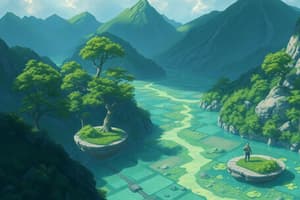Podcast
Questions and Answers
What are the four physical components of our environment?
What are the four physical components of our environment?
- Clouds, Rocks, Sand, and Heat
- Coal, Gasoline, Sunlight, and Trees
- Water, Air, Soil, and Light (correct)
- Wind, Fire, Earth, and Metal
Why are freshwater sources crucial for agriculture and human consumption?
Why are freshwater sources crucial for agriculture and human consumption?
- To filter pollutants
- To generate electricity
- To improve soil quality
- To irrigate crops and provide drinking water (correct)
What is the role of air in the environment?
What is the role of air in the environment?
- It absorbs sunlight
- It causes erosion
- It produces water through evaporation
- It provides oxygen for respiration (correct)
Which unique ecosystems help filter pollutants from flowing water?
Which unique ecosystems help filter pollutants from flowing water?
What processes contribute to maintaining balance in the environment?
What processes contribute to maintaining balance in the environment?
In our environment, what role does light play?
In our environment, what role does light play?
What is the primary impact of deforestation on soil?
What is the primary impact of deforestation on soil?
How do changes in light patterns impact ecosystems?
How do changes in light patterns impact ecosystems?
What services do ecosystems provide according to the text?
What services do ecosystems provide according to the text?
Which activity has contributed significantly to increasing pollution levels in air, water, and soil?
Which activity has contributed significantly to increasing pollution levels in air, water, and soil?
What is the main driver of deforestation mentioned in the text?
What is the main driver of deforestation mentioned in the text?
Why is biodiversity considered essential for maintaining ecological stability?
Why is biodiversity considered essential for maintaining ecological stability?
Study Notes
Our Environment - A Brief Overview
Our environment encompasses all living organisms, including humans, animals, plants, and microorganisms, along with their physical surroundings such as water, air, soil, and sunlight. It is a dynamic system where every part interacts with others to form complex networks of relationships. Understanding our environment is crucial because it provides us with essential resources like food, water, and energy while also influencing our quality of life on multiple levels. In this brief overview, we will focus on different aspects of our environment that make up this intricate system.
Physical Aspects
The physical components of our environment are composed of four elements: water, air, soil, and light. These elements interact through various processes such as photosynthesis, evaporation, precipitation, erosion, and decomposition, which contribute to maintaining balance and supporting life.
Water
Water cycles between oceans, lakes, rivers, and the atmosphere, maintaining a delicate balance vital for life. Freshwater sources are crucial for agriculture and human consumption, making water conservation critical. Unique ecosystems, called wetlands, help filter pollutants from flowing water before it reaches drinking water sources.
Air
Air plays a significant role in our environment by providing oxygen for respiration and transporting gases necessary for photosynthesis. Pollution, deforestation, and climate change have introduced challenges, affecting the health of both the planet and its inhabitants.
Soil
Soil is essential for terrestrial plant growth, storing carbon, and stabilizing landslides. However, environmental factors like deforestation and overuse can lead to soil degradation, affecting its fertility and stability.
Light
Light is vital for life, providing energy for photosynthesis and regulating circadian rhythms. Changes in light patterns, such as those caused by climate change, can disrupt these rhythms, impacting ecosystems and their inhabitants.
Biological Aspects
The biological components of our environment include all living organisms, from microorganisms to mammals, plants, and fungi. These organisms interact with one another and their physical surroundings, forming complex food webs and nutrient cycles.
Ecosystems
Ecosystems are complex networks of relationships between organisms and their physical surroundings. They provide a range of ecosystem services, including provisioning (food, water, timber), regulating (climate, floods, soil), cultural (recreation, aesthetics), and supporting (habitat, nutrient cycling).
Biodiversity
Biodiversity refers to the variety of life on Earth, including genetic diversity within species, species diversity within ecosystems, and ecosystem diversity across the planet. This diversity is essential for maintaining ecological stability and resilience, providing essential resources, and supporting human well-being.
Human Impact
Human activities have had a significant impact on our environment, leading to changes in the natural balance and degradation of resources. Some of the primary human-induced environmental challenges include:
Climate Change
Human activities, such as burning fossil fuels and deforestation, have increased levels of greenhouse gases in the atmosphere, leading to global warming and climate change. This phenomenon has far-reaching consequences, affecting weather patterns, sea levels, and ecosystems.
Pollution
Industrial activities, transportation, and waste disposal have led to increased pollution levels in air, water, and soil. Pollution can have severe health consequences for both humans and wildlife, affecting ecosystems and human well-being.
Deforestation
Deforestation, primarily driven by agricultural expansion and urbanization, has led to the loss of forests, which are vital for maintaining ecological balance and supporting biodiversity.
Overexploitation of Resources
Overexploitation of resources, such as water, minerals, and energy, can lead to depletion and scarcity. Sustainable resource management is crucial for maintaining ecological balance and supporting human well-being.
In conclusion, our environment is a complex and interconnected system that provides essential resources and influences our quality of life. Understanding the physical and biological components of our environment and the challenges posed by human activities is crucial for ensuring its preservation and supporting human well-being. By working together, we can strive to maintain ecological balance and protect our environment for future generations.
Studying That Suits You
Use AI to generate personalized quizzes and flashcards to suit your learning preferences.
Description
This quiz provides a brief overview of our environment, covering its physical and biological aspects, including water, air, soil, light, ecosystems, biodiversity, and the impact of human activities. Explore how different components interact to form complex networks and the challenges posed by climate change, pollution, deforestation, and resource overexploitation.




